Cats have many unusual behaviors. Some are pleasant, but some are really a headache for the owners. Vomiting is one of those unpleasant behaviors of cats. It is obviously not a normal thing. If your cat continues to vomit undigested food, it can be a symptom of serious illness. You are concerned about your cat’s health, and that might be the reason you have searched; why is my cat throwing up undigested food, aren’t you? Well, you have arrived at the correct place because here we will give you in-depth information and the possible reasons for vomiting. So, buckle up, and let’s get started.
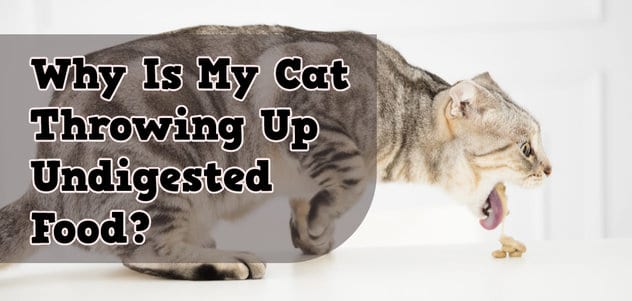
Vomiting is actually considered to be a nonspecific symptom. It is usually connected with a large number of health issues, namely internal obstruction, hairballs, constipation, indigestion, and more. That’s why it is literally hard to target any particular reason. So, before identifying the exact reasons, you need to first understand what is making your cat vomit.
Contents
The Difference Between Vomiting and Regurgitation
Vomiting and regurgitation may seem similar from the outside, but it’s important to know the difference. This will help you and your vet treat your cat more effectively.
There is often confusion among cat owners about the difference between regurgitation and vomiting. However, regurgitation typically involves bringing up undigested food from the stomach, while vomiting includes digested material.
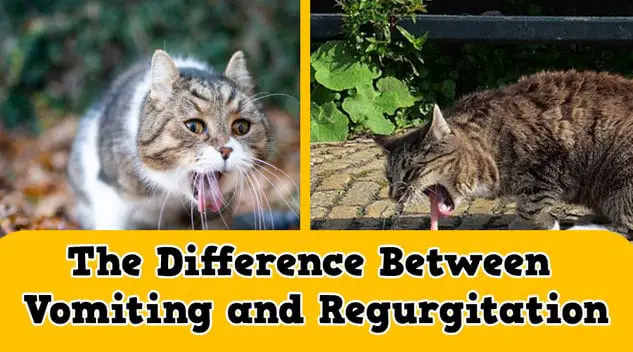
Vomiting makes all the stomach content ejected. This includes food, water, bile, and others. Vomiting is accompanied by retching, contraction of the abdominal muscle, nausea, etc.
When a cat regurgitates, it means that the contents of its stomach are coming back up into its mouth. This is different from vomiting, where food and water are involved. Regurgitation doesn’t require the cat to do anything special, like retching or vocalizing. Instead, the cat will just lower its head, and the contents will fall out of its mouth.
Why Is My Cat Throwing Up Undigested Food?
Eating Too Fast
In some cases, cats seem to eat too fast. Besides, some cats love to eat quickly. This quick behavior while taking the foods can be a curse for them. It can cause regurgitate, for which your cat may throw undigested food. Food puzzles can help you out to prevent this type of behavior. It can slow them down while delivering proper nutrition to your cat in a fun way. Food puzzles also slow down the chew time, and that’s why the cats can’t eat quickly. Well, that’s a plus of the food puzzles.
Food
Some cats are allergic to certain types of foods. If your cat is also one of them, then this can be a reason which is causing them to vomit. In this case, you have to pay proper attention to the foods. Instead of picking any random foods, you should search for the best cat food for older cats that vomit. If your vet has found some health issues in your cat and ruled out some specific type of food, you must not avoid them. It can be dangerous for your cat.
Food allergies are often caused by the protein. If things go wrong, your vet may put your car on a strict diet plan of hydrolyzed protein. Do you know what a hydrolyzed diet actually is? It is actually a process where two different amino acid components are created by breaking the protein. Due to this process, the immune system of a cat can’t identify the allergens. As a result, the allergy symptoms can’t flare up in your cat.
Hairballs
Unlike other animals, cats love to keep themselves clean. While they attempt to groom themselves, dead hairs and tiny hook-like items may stick in their tongue and end up in their stomach. Most of the hairs or small particles go through their digestive tracts normally. But sometimes, the hairs remain in the stomach forming a hairball. Well, that can be a matter of concern.
Hairballs are one of the worst problems for cats. It can cause the cats to vomit up undigested foods. Although it is an occasional phenomenon, it is still a headache for cat owners. You should pay proper attention to prevent the problem. Many natural remedies are available to prevent hairballs. You can use them with confidence because they do not contain any dangerous substances.
Changes in Their Regular Foods
Cats are carnivores, and they don’t usually like changes in their food or the food schedule. So, if there is a change in the food schedule or the regular foods, you may see your cat regurgitating undigested foods.
If you’ve recently switched your cat’s food, this can also be the cause of their upset stomach. It’s therefore best not to change your cat’s food too frequently, and to gradually transition them to a new food over the course of one to two weeks.
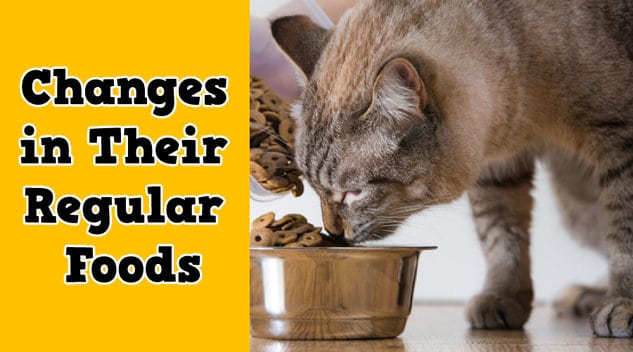
Hairballs are one of the most pesky problems for cats. They can cause the cats to vomit up undigested foods, which is not only gross, but also a headache for cat owners. Paying proper attention to your cat’s grooming habits can help prevent hairballs from becoming a problem.
Eating Quickly
If your cat is eating quickly, then he might suffer from regurgitation. That’s why you also have to pay proper attention to this fact. Instead of letting your cat eat too much, you should go for smaller and more frequent meals. In this case, you can take your vet’s suggestion. He will help you to determine how much food is good for your cat without being fed too much.
Gastritis
If your cat is having gastritis, then chances of vomiting and regurgitation are more. The symptoms of gastritis will show several unusual things that your cat has never shown before. When your cat is encountered with gastritis, you may notice vomiting undigested food, bile, or even blood. Your cat may also face a lack of appetite, dehydration, lethargy, and more. If you notice any of these initial symptoms, you must contact your vet as soon as possible. They will provide you with a better remedy.
Some Other Reasons
- Esophageal irritation
- Constipation
- Presence of foreign material in the intestinal tract
- Motility disorders
When Should I Be Concerned About My Cat Vomiting?
Some cat owners may not have shown their concern about the vomiting behavior, but frequent vomiting is obviously not a good sign for the cats. If your cat is vomiting more than once a week, you should start paying the required attention. Obviously, it is not normal for cats. If you notice that your cat is vomiting undigested food more than several times a day, then you will have to be concerned about it. And without wasting any time, you should fix an appointment with your vet.
Your vet will then start with the physical exam, inspect all the vital signs and check your cat’s abdominal. He may want to run more tests like blood and X-rays to ensure if the body parts are working properly. Based on the reports, blood cells, and platelet levels, your vet may run surgery or another essential medication.
Types of Cat Vomit
Your cat might have been throwing undigested food in different forms and colors. As you are not an expert and don’t know what this indicates, you searched for “Why is my cat throwing up undigested food?” Okay, let’s clear the fact from here. So, Why is my cat throwing up undigested food? Well, there can be several reasons for that.

Throwing the foods can be categorized into two different categories; one is chronic, and the other one is acute.
Here chronic vomiting means throwing up the food with some regularities, maybe once or twice in a month or more than that. Each occurrence can make a cat vomit once or twice. But when a cat starts vomiting more than before, it turns into an acute issue. This is the time when you should be concerned about. The treatment and diagnostic procedures are different from acute and chronic vomiting.
If your cat more than three times and can’t keep the food inside, then you will have to consider this as an acute vomiting behavior. This can make your cat prone to many changes and can even lead them to several types of health issues, notably liver diseases. That’s why acute vomiting needs more urgent care. You should set an appointment with your vet as soon as possible.
A chronic vomiting cat also needs special attention, but it is not as urgent as the acute one. This is especially when your cat is still able to keep the food inside of his belly. In this case, you will not see any types of visual symptoms or weakness. But if the symptoms are visible, chronic vomiting can turn into acute vomiting at any time.
In the past, vets or doctors didn’t consider times vomiting as anything serious. But things have completely changed now. At present, vets suggest paying proper attention to the vomiting behavior in the cats. If a cat is frequently vomiting, then he might be suffering gastritis or any other health issues.
You can check it to Serve Pate Cat Food
Causes of Vomiting in Cats
We have already discussed some reasons behind vomiting. Although most of them are the same for acute and chronic, there are still some exceptions. We usually consider toxin elements as the main reason for vomiting, but those aren’t always the culprit
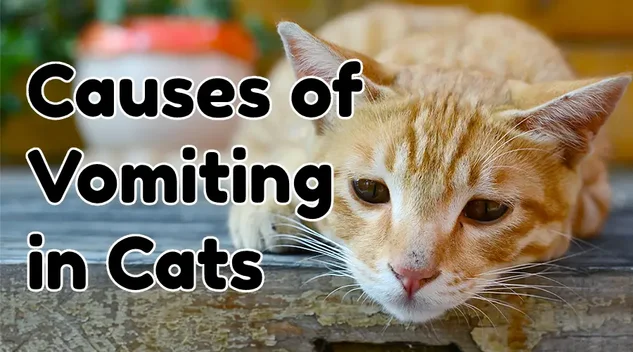
In this case, the ingestion of a foreign body can play a great role. Vomiting can be placed in these categories:
- Toxins
- Drugs
- Intestinal
- Diet
- Gastric
- Organ dysfunction
- Neurologic
- Infectious
- Endocrine
- Cancer
Diagnosing the Cause of Vomiting
Diagnosing a vomiting cat can be really difficult. But in most cases, acute vomiting can be treated with symptomatic therapy. So, first of all, you are gonna have to identify the exact reason by asking some common questions like:
- Did the cat eat plants or other toxins?
- What are the normal diets of your cat?
- When did the vomiting issue start?
- Does the cat hunt when it goes outside?
- Is the cat taking any medicines?
- Is the cat suffering from diarrhea?
- When does the vomiting actually occur?
- Is the cat drinking a lot or urinating a lot?
- Is the cat eating properly?
These questions will help you to understand the facts. Besides, your vet may also ask you these questions to determine whether the vomiting condition is acute or chronic. Based on the answers, he/she will suggest the medicines for your cat. Sometimes they may also ask the color of the vomit. The color of the vomit is also essential in identifying the cause of vomiting.
Reasons for Cat Vomiting by Color
Pet’s vomit can be different in color. But mainly, we can see red, yellow, and green color vomits. Although the colors aren’t anything to do with their illness, they can still deliver an initial indication. And that’s what can lead your vet to the right path. So, let’s see what the different color of the vomit indicates.
Why Is My Cat Vomiting Yellow?
Yellow vomit represents regurgitation. The yellow color is typically the acids of the stomach and bile. The stomach acid is released to aid digestion. And the fluid stored in the liver and the gallbladder is known as bile. This assists digestion by entering the duodenum.
When you have found that your cat is throwing yellow liquid, it is a sign that the stomach of your cat is empty. The acids inside of your cat’s stomach are irritating the normal functions of the stomach and causing it to vomit. You can see this yellow vomit when your cat is hungry. Aside from this issue, there are many other diseases that can cause your cat to vomit. The diseases are numerous, but below, we have listed some common diseases. Let’s have a look at them.
- Gastritis
- Constipation
- Pancreatitis
- Indigestion
- Hyperthyroidism
- Diabetes
- Liver disease
- Kidney disease
- Cholangiohepatitis and more
Why Is My Cat Vomiting Green Liquid?
The green color liquid indicates that the vomit has been brought from another location after the stomach. The vomit substances take green or greenish color due to the addition of bile and bile substances.
Well, the green vomits aren’t always a matter of concern, to be honest. In fact, it is also caused by stomach fluid. Your cat might have been eaten some toxic substances, or he might have been suffering from GI upset. Like other animals, cats don’t get bugs in their stomach, but they can have infections. And these infections in their stomach can lead them to vomit green or in other colors. Dehydration, indigestion, inadequate chewing can be the main reason behind their green vomits. That’s you should take proper steps to prevent these issues. The laxity of fluid in their bowel can also lead them to vomit. Inspect your cats’ behavior and take your vet’s suggestion to solve this problem.
Why Is My Cat Vomiting White Foam and Not Eating?
There are several reasons that can make your cat vomit white foam. But the possible reason is gastritis. So, you need to concentrate on the foods and eating behavior of your cat. The consistency of this white foam vomiting also indicates the health condition of your cat. You need to learn how to differentiate between white foam, white mucus, and white liquid.
Your cat can sometimes eat too fast. Besides, like the previous reasons, overeating, running off towards the meal quickly can possibly lead your cat to vomit or to throw white foam. The obstruction in the GI tract is also responsible for this. Some young kittens may not have dewormed when you brought them home. This now is causing an imbalance in your cat’s bowel system. Parasitic infection is one of the serious problems. If you notice any symbol of parasitic infection, you need to act quickly and visit your vet’s house.
Why Is My Cat Vomiting Bile and Lethargy?
Bile is actually a green substance produced inside of the liver of a cat. This actually aids the digestion of food. But if your cat has started to vomit with bile, then it is alarming for both the cat and cat owners. In some cases, it is literally hard for the cat owners to identify bile because animals are likely to clean them up. If you can’t catch your cat at the time of vomiting, it will be really hard to find it out. This also makes it hard to determine how long this issue has been occurring. However, let’s have a look at some possible symptoms of vomiting with bile in cats.
Vomiting with bile usually happens in the early morning or early evening. During this time, the stomach of a cat remains empty. But why does this happen?
Well, the main reason for vomiting with bile is occasional long-term vomiting. In addition to this, bile vomiting can also occur due to weight loss, disinterest in food, excessive drooling, and others.
If your cat is throwing bile for three days, then you have to move forward for his better treatment. This can lead your cat to several health issues and can make him suffer in the long run. Their new food or eating behavior can be the main reason behind this. Besides, we have already discussed the possible reasons. The improper diet and parasites can make your cat throwing up bile for several days. That’s why it is ideal to find appropriate food for your cat. Don’t worry; there are numerous remedies for your cat. If you can follow one of those and provide your cat with the prescribed remedies, your cat will recover fully from this issue. Most cats affected cat will respond quickly with proper medicines or with dietary supplements. So, visit your vet and follow his instruction to save your cat.
Home Remedy for Cat Vomiting and Diarrhea
Diarrhea is often painful for cat owners, and this encounters the cats most of the time. The interesting fact is that diarrhea is also connected with frequent vomiting. So, if your cat is suffering from diarrhea, you need to take the necessary steps for its prevention. Here are some options for treating cat diarrhea.
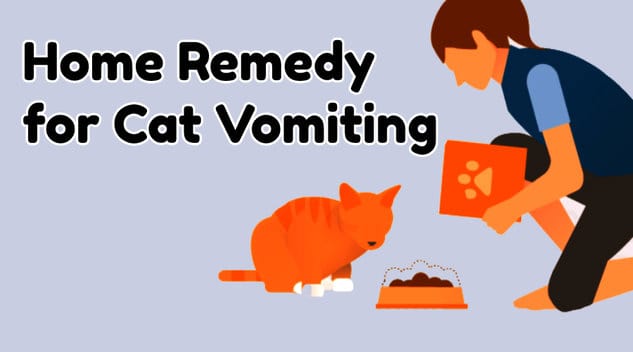
Options for Treating Cat Diarrhea
Once you have identified the type of diarrhea and if he is in the condition of taking home remedies, you have to choose a proper type of treatment for your cat. Here we have listed five options for treating a cat’s diarrhea.
Change Cat Food
Sometimes the food of your cat can be the main culprit. So, you have to start with the food first. It is recommended to simplify the diet of your cat. The complicated diet and food items can hinder the intestinal process and the healing ability of a cat.
If you have changed your cat’s diet recently and noticed this diarrhea issue, then you should go back where you were previously. The ingredients of the new food may not be incorporating into your cat’s bowel system. So, it will be better if you inspect your cat’s behavior after changing the food.
Even if you are using the foods from the same brand and type, the ingredients can have an adverse effect on their gut. This type of issue will be most commonly seen in cats who have a sensitive gut or have allergenic issues.
Fiber
Some low fiber cat food can help to treat diarrhea properly. If your cat wasn’t suffering from diarrhea but started to produce more stool, then a low fiber food should be a worth try. In this case, you should search for foods that are highly digestible and contains a low amount of fiber.
Anti-Diarrheal Medications
Before diving into any anti-diarrheal medications, it is always recommended to take your vet’s supervision. Otherwise, things can go worse. Among many dangerous medicines, the kaolin-pectin medications can be used for your cat’s diarrhea without being worried about anything. It dosing instruction is simple and will be clearly given on the product. You should use one tablespoon per pound of body weight. The doses should be used within every four to five hours. Make sure to check the product before using it. At present, there are many fake products with the name tag of Kaolin pectin. Beware of that.
Probiotics
Healthy bacteria can help the cat to bring its gut onto the right track. In this case, prebiotics can play a great role. These healthy bacteria are also essential for a cat’s better digestion. They usually have some good bacteria in their gut, but when they are disrupted, issues like diarrhea takes place. There is numerous Probiotic supplement that can help your cat and bring the intestinal bacterial growth to be normal. Make sure to pick a probiotic that is labeled or specifically made for the cats.
Homemade Cat Food for Upset Stomach
Here are some homemade foods for treating your cat’s upset stomach.
Fasting
When your cat has an upset stomach, it will be helpful to give your cat a rest. During this time, you may see that your cat is avoiding additional eating. He may only eat when he feels hungry. However, if he still wants to eat more than necessary, you should keep the food away from his reach. It is better to keep the food away for 12 to 24 hours after giving their meal. During the fast, make sure to provide your cat with adequate water. This will help them to prevent dehydration.
Hydration Check
If your cat has started to vomit or suffer from diarrhea recently, he might have started to lose fluids. In order to check the hydration level, pull up the shoulder skin and see how quickly it springs back.
A well-hydrated cat will spring back immediately where a dehydrated skin will delay and remain lifted. In this case, you have to ensure adequate fluid supply based on the suggestion of your vet.
Fluid
In some cases, normal drinking water can lead your cat to diarrhea and an upset stomach, and you have to ensure adequate fluids for keeping everything on the right track. You can give your cat ice chips to lick, which can help them to recover the fluid amount.
Changing Cat Food Problems
From the above discussion, it is clear that you will have to change your cat’s food when he is facing the vomiting and diarrhea issue. But how to do this? Changing regular food can trigger another issue in your cat. So, it is always recommended to change the food of your cat gradually.
Pet Food Trends
Instead of giving a new food to your cat, you should introduce your cat to the food eventually. You should distribute the food amount to 60/40. And in every meal, you should increase the portion a little bit than the previous one. This will help your cat to change his eating habit and increase his interest in the new food.
Conclusion
Hopefully, the above discussion was helpful for you, and you won’t have to search” Why is my cat throwing up undigested food?” again. The issues largely depend on the food, so you should focus on changing the food based on their health issues. There are numerous great-tasting, nutritional foods which can be used as a remedy for your cat’s health issues. Find one of the best cat food, and you will see your cat lip-smacking with its pleasing taste.

